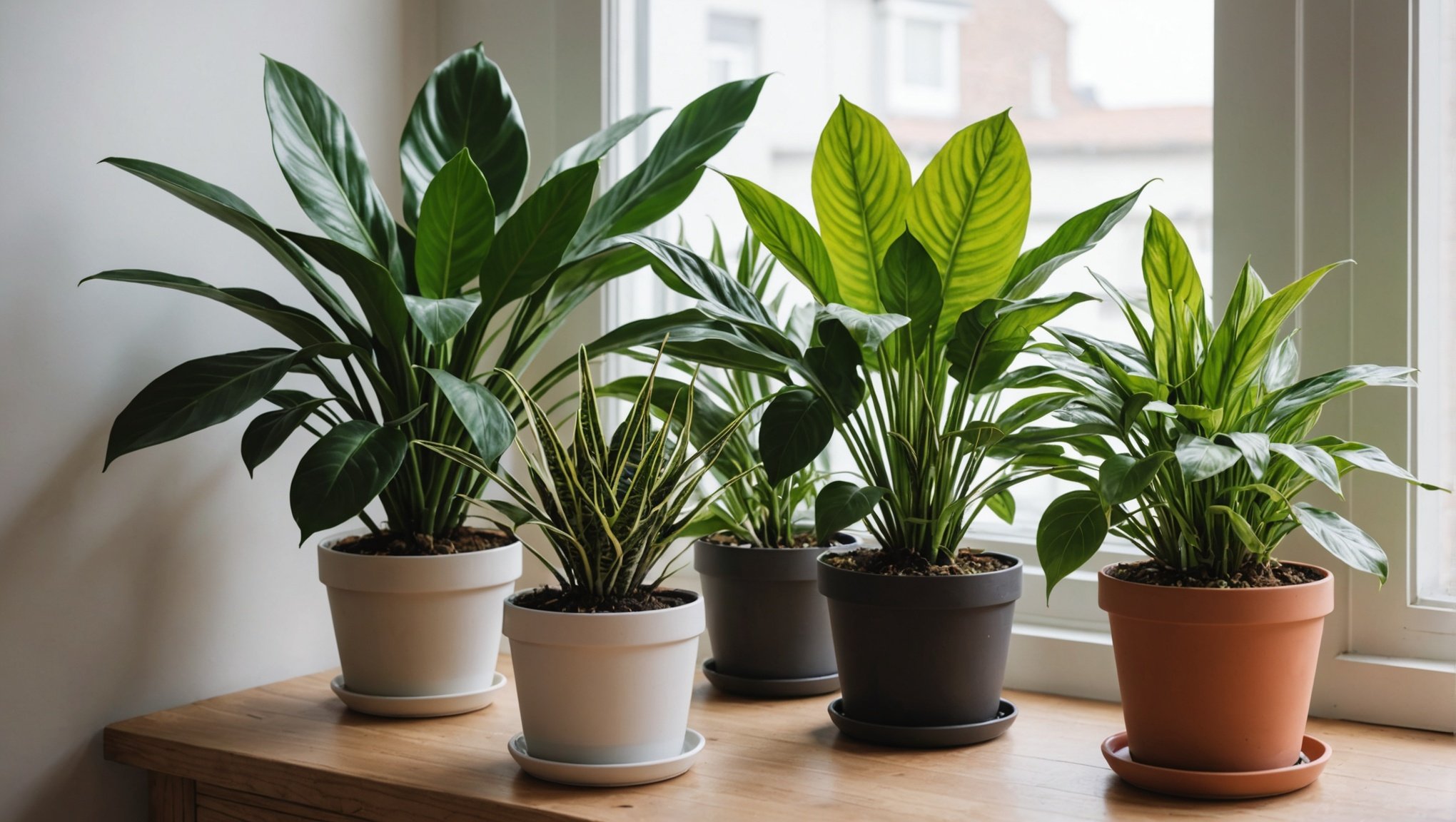Creating an Allergy-Friendly Sanctuary: Top Indoor Plants for Allergy Sufferers
When it comes to managing allergies, transforming your home into an allergy-friendly sanctuary is crucial. One of the most effective and aesthetically pleasing ways to achieve this is by incorporating the right indoor plants. These plants not only beautify your space but also play a significant role in purifying the air, reducing allergens, and creating a healthier environment.
Understanding the Benefits of Indoor Plants
Indoor plants are more than just decorative elements; they are natural air purifiers and mood boosters. According to a study conducted by NASA, certain plants are exceptionally good at removing toxins from the air, such as carbon dioxide, and producing fresh oxygen through photosynthesis.
Additional reading : Top Materials for Crafting a Long-Lasting and Chic Treehouse in Your UK Garden
Air Purifying Plants
Here are some of the best air purifying plants that are perfect for an allergy-friendly home:
- Spider Plant: Known for its ease of care and ability to remove air pollutants like formaldehyde and xylene.
- Peace Lily: This plant is a powerhouse in air purification, removing toxins like ammonia, benzene, and trichloroethylene. It also helps in reducing humidity, which can prevent mold growth.
- Snake Plant: Also known as Mother-in-Law’s Tongue, this plant is low-maintenance and effective in removing formaldehyde, benzene, and trichloroethylene from the air.
- Bamboo Palm: This plant is excellent for removing trichloroethylene, benzene, and formaldehyde, making it a great addition to any room.
Low-Pollen Plants for Allergy Sufferers
For individuals suffering from hay fever or other pollen-related allergies, choosing low-pollen plants is essential.
In the same genre : Top Energy-Efficient Lighting Options to Brighten Your Home Office
Plants That Are Low in Pollen
Here are some plants that are less likely to aggravate allergies:
- Ferns: These plants are not only low in pollen but also add a touch of greenery to any room.
- Azaleas: While they produce flowers, azaleas are known to be low-pollen plants and can be a beautiful addition to your indoor garden.
- Hostas: These plants are popular for their low-maintenance requirements and minimal pollen production.
How Indoor Plants Improve Air Quality
Indoor plants are natural air purifiers that work tirelessly to improve the air quality in your home.
Mechanism of Air Purification
During photosynthesis, plants absorb carbon dioxide and release oxygen. Here’s a detailed look at how some of these plants work:
| Plant | Air Pollutants Removed | Additional Benefits |
|---|---|---|
| Spider Plant | Formaldehyde, Xylene | Easy to care for, great for beginners |
| Peace Lily | Ammonia, Benzene, Trichloroethylene | Helps in reducing humidity, beautiful white blooms |
| Snake Plant | Formaldehyde, Benzene, Trichloroethylene | Low-maintenance, can thrive in low-light conditions |
| Bamboo Palm | Trichloroethylene, Benzene, Formaldehyde | Effective air purifier, adds a tropical touch to the room |
Practical Tips for Indoor Gardening
To ensure your indoor plants thrive and continue to purify the air effectively, here are some practical tips:
- Lighting: Most indoor plants prefer bright, indirect light. However, some like the snake plant can tolerate low light conditions.
- Watering: Overwatering is a common mistake. Check the soil moisture before watering, and avoid getting water on the leaves to prevent fungal diseases.
- Humidity: Some plants like the peace lily prefer higher humidity levels. You can use a humidifier or place the plant on a tray filled with water and pebbles to increase the surrounding humidity.
- Temperature: Most indoor plants prefer temperatures between 65°F to 75°F (18°C to 24°C).
Additional Tips for an Allergy-Friendly Home
While indoor plants are a significant step towards creating an allergy-friendly home, there are other measures you can take to enhance the environment.
Cleaning and Maintenance
Regular cleaning is crucial to reduce allergens like dust mites, pet dander, and pollen.
- Vacuum and Sweep: Use a vacuum cleaner with a HEPA filter to trap allergens. Sweep and mop floors regularly to remove dust and other particles.
- Avoid Toxic Cleaners: Opt for cleaning products that are free from harmful chemicals like phthalates, parabens, and formaldehyde. These chemicals can exacerbate allergic reactions.
Air Purifiers and Ventilation
In addition to plants, using air purifiers and ensuring good ventilation can significantly improve air quality.
- Air Purifiers: Consider investing in an air purifier, especially in rooms where you spend a lot of time, like the bedroom. These devices can help remove pollutants like mold spores and pesticides from the air.
- Let in Fresh Air: Open windows and doors to allow fresh air in. This can help reduce indoor pollutants and improve overall health.
Creating a Friendly Indoor Space
Transforming your home into an allergy-friendly sanctuary involves more than just adding plants; it’s about creating a holistic environment that supports your health.
Bedroom Plants
The bedroom is where you spend a significant amount of time, so it’s crucial to ensure it’s free from allergens.
- Peace Lily: This plant is not only an excellent air purifier but also helps in reducing humidity, making it ideal for bedrooms.
- Snake Plant: Known for its ability to purify the air even in low-light conditions, the snake plant is a great choice for bedrooms.
Gardening Indoor: A Fun and Therapeutic Activity
Indoor gardening is not just about maintaining plants; it’s a therapeutic activity that can reduce stress and improve mental health.
- Start Small: Begin with easy-to-care-for plants like succulents or spider plants. These plants are perfect for beginners and can help you build confidence in your gardening skills.
- Experiment with Different Plants: Once you gain experience, you can experiment with different types of plants. This can add variety to your indoor garden and keep the process interesting.
Creating an allergy-friendly sanctuary is a multifaceted approach that involves incorporating the right indoor plants, maintaining a clean and well-ventilated home, and avoiding toxic substances. By choosing low-pollen plants, ensuring proper care and maintenance, and integrating additional measures like air purifiers and regular cleaning, you can significantly improve the air quality in your home.
Final Tips and Recommendations
- Consult a Healthcare Professional: If you have severe allergies, consult with a healthcare professional before introducing new plants into your home.
- Monitor Your Environment: Keep an eye on how your body reacts to different plants and adjust your indoor garden accordingly.
- Enjoy the Process: Indoor gardening is a rewarding hobby that not only improves your health but also adds beauty and life to your space.
By following these tips and recommendations, you can create a home that is not only aesthetically pleasing but also a haven for allergy sufferers. So, start your journey towards a healthier, more allergy-friendly home today






